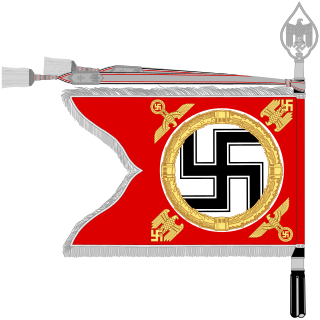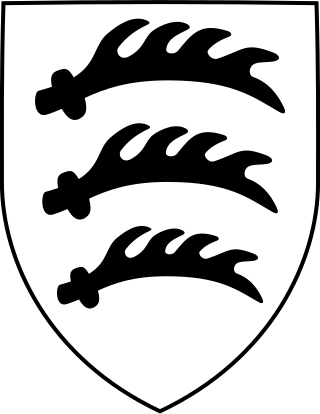The Fallschirm-Panzer-Division 1. Hermann Göring was a German elite Luftwaffe armoured division. The HG saw action in France, North Africa, Sicily, Italy and on the Eastern Front during World War II. The division began as a battalion-sized police unit in 1933. Over time it grew into a regiment, brigade, division, and finally was combined with the Parachute-Panzergrenadier Division 2 Hermann Göring on 1 May 1944 to form a Panzer corps under the name Reichsmarschall. It surrendered to the Soviet Army near Dresden on 8 May 1945.

The 78th Infantry Division, later known as the 78th Assault Division, was a German infantry formation which fought during World War II. After the 78th Assault Division was destroyed near Minsk in July 1944, the 78th Volksgrenadier Division was created.
The Panzerkorps Großdeutschland was a German panzer corps in the Wehrmacht which saw action on the Eastern Front in 1944/1945 during World War II.

The Battle of Narva Bridgehead was the campaign that stalled the Soviet Estonian operation in the surroundings of the town of Narva for six months. It was the first phase of the Battle of Narva campaign fought at the Eastern Front during World War II, the second phase being the Battle of Tannenberg Line.

The Battle of Tannenberg Line or the Battle of the Blue Hills was a military engagement between the German Army Detachment Narwa and the Soviet Leningrad Front. They fought for the strategically important Narva Isthmus from 25 July–10 August 1944. The battle was fought on the Eastern Front during World War II. The strategic aim of the Soviet Estonian Operation was to reoccupy Estonia as a favorable base for the invasions of Finland and East Prussia. Waffen-SS forces included 24 volunteer infantry battalions from the SS Division Nordland, the SS Division Langemarck, the SS Division Nederland, and the Walloon Legion. Roughly half of the infantry consisted of the personnel of the 20th Waffen Grenadier Division of the SS. The German force of 22,250 men held off 136,830 Soviet troops. As the Soviet forces were constantly reinforced, their overall casualties are estimated by Estonian historian Mart Laar to be 170,000 dead and wounded.
This is the complete order of battle of Allied and German forces involved during Operation Market Garden.

The siege of Breslau, also known as the Battle of Breslau, was a three-month-long siege of the city of Breslau in Lower Silesia, Germany, lasting to the end of World War II in Europe. From 13 February 1945 to 6 May 1945, German troops in Breslau were besieged by the Soviet forces which encircled the city as part of the Lower Silesian Offensive Operation. The German garrison's surrender on 6 May was followed by the surrender of all German forces two days after the battle.

The Führerbegleitbrigade was a German armoured brigade and later an armoured division (Panzer-Führerbegleitdivision), in World War II. It grew out of the original Führer-Begleit-Battalion formed in 1939 to escort and protect Adolf Hitler at the front. It was formed in November 1944 and destroyed in April 1945.

Operation Martlet was part of a series of British attacks to capture the French town of Caen and its environs from German forces during the Battle of Normandy of World War II begun by the Allies. It was a preliminary operation undertaken on 25 June 1944 by XXX Corps of the British Second Army, to capture Rauray and the area around Noyers. The attack was to protect the right flank of VIII Corps as it began Operation Epsom, an offensive into the Odon Valley west of Caen, on 26 June. The 50th (Northumbrian) Infantry Division and the 49th Infantry Division were to capture Juvigny-sur-Seulles, Vendes and Rauray, to prevent German counter-attacks against VIII Corps from the area of the Rauray Spur and then extend the attack towards Noyers and Aunay-sur-Odon. It was the first time in Normandy that the 49th Division operated as a division.
The 563rd Volksgrenadier Division was a volksgrenadier division of the German Army during the Second World War, active from 1944 to 1945.

The 25th Infantry Division was a military unit of the German Wehrmacht. It was later reclassified to 25th Motorized Infantry Division, and in June 1943 to the 25th Panzergrenadier Division.

This is a sub-article to Battle of Narva (1944).
The 708th Infantry Division was a German Army infantry division in World War II.
The Battle of Monte Cassino order of battle for January 1944, is a listing of the significant formations involved in the fighting on the Winter Line in January 1944, during the period generally known as the First Battle of Monte Cassino.

This is the Juno Beach order of battle on D-Day.
This is the order of battle for German Wehrmacht and the Soviet Red Army engaged in the battle in Berlin. The investment of Berlin began about 21 April 1945, it was followed by the assault and the capture of the city by the Soviets on 2 May 1945.
The 549th Volksgrenadier Division was a volksgrenadier infantry division of the German Army during World War II, active from 1944 to 1945. It was formed as the 549th Grenadier Division in July 1944 and became a volksgrenadier division several months later. Fighting on the Eastern Front, it was nearly destroyed in the East Prussian Offensive, with its remnants retreating west and surrendering to American troops at the end of the war.
The 65th Guards Rifle Division was formed as an elite infantry division of the Red Army in May, 1943, based on the 2nd formations of the 75th and 78th Rifle Brigades, and served in that role until after the end of the Great Patriotic War. Along with its "sister", the 56th Guards Rifle Division, the 65th was formed "out of sequence", that is, many Guards rifle divisions were higher numbered and formed earlier than the 65th. The division was immediately assigned to the 19th Guards Rifle Corps of the 10th Guards Army and remained under those headquarters for the duration of the war. It first saw action in Western Front's summer offensive, Operation Suvorov. During the winter of 1943-44 it took part in the stubborn fighting north and east of Vitebsk, first in Western and later in 2nd Baltic Front. During the following summer offensives it helped break through the defenses of the German Panther Line and advanced into the Baltic states, eventually receiving a battle honor for its part in the liberation of Riga. For the rest of the war it was part of the forces blockading the remnants of German Army Group North in the Courland Pocket in Latvia, eventually in Leningrad Front. After the war the 65th Guards was moved to Estonia where it was disbanded in 1947.
The 73rd Guards Rifle Division was reformed as an elite infantry division of the Red Army in March 1943, based on the 2nd formation of the 38th Rifle Division, and served in that role until after the end of the Great Patriotic War.













